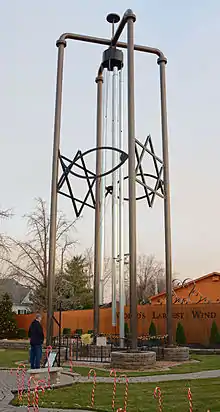Casey | |
|---|---|
 Casey city hall | |
| Nickname: a Small Town with a Big Heart[1] | |
 Location of Casey in Clark County, Illinois. | |
.svg.png.webp) Location of Illinois in the United States | |
| Coordinates: 39°18′11″N 87°59′23″W / 39.30306°N 87.98972°W[2] | |
| Country | United States |
| State | Illinois |
| Counties | Clark, Cumberland |
| Townships | Casey, Union |
| Government | |
| • Mayor | Nik Groothuis[3] |
| Area | |
| • Total | 2.64 sq mi (6.83 km2) |
| • Land | 2.62 sq mi (6.79 km2) |
| • Water | 0.01 sq mi (0.04 km2) |
| Elevation | 646 ft (197 m) |
| Population (2020) | |
| • Total | 2,404 |
| • Density | 916.86/sq mi (353.96/km2) |
| Time zone | UTC-6 (CST) |
| • Summer (DST) | UTC-5 (CDT) |
| ZIP code | 62420 |
| Area code | 217 |
| FIPS code | 17-11618 |
| GNIS feature ID | 2393765[2] |
| Wikimedia Commons | Casey, Illinois |
| Website | http://www.cityofcaseyil.org/ |
Casey (pronounced KAY-zee[5]) is a city in Clark and Cumberland counties in the U.S. state of Illinois. The population was 2,404 at the 2020 census.
The Cumberland County portion of Casey is part of the Charleston–Mattoon Micropolitan Statistical Area.
Casey is the home to several Guinness World Record constructions - super-sized items in the form of outdoor sculptures—including the Wind Chime, Rocking Chair, Knitting Needles, Crochet Hook, Pitchfork, Golf Tee, Yardstick, Wooden Token, Dutch Wooden Shoes, Mailbox, Pencil and Birdcage.
Geography
Most of the city lies in Clark County, although a small portion extends into Cumberland County. In the 2000 census, 2,940 of Casey's 3067 residents (99.9%) lived in Clark County and 2 (0.1%) lived in Cumberland County.[6]
According to the 2021 census gazetteer files, Casey has a total area of 2.26 square miles (5.85 km2), all land.[7]
Climate
| Climate data for Casey, Illinois, 1991–2020 normals, extremes 1893–present | |||||||||||||
|---|---|---|---|---|---|---|---|---|---|---|---|---|---|
| Month | Jan | Feb | Mar | Apr | May | Jun | Jul | Aug | Sep | Oct | Nov | Dec | Year |
| Record high °F (°C) | 72 (22) |
76 (24) |
87 (31) |
89 (32) |
97 (36) |
100 (38) |
102 (39) |
102 (39) |
99 (37) |
95 (35) |
83 (28) |
72 (22) |
102 (39) |
| Mean daily maximum °F (°C) | 37.5 (3.1) |
42.5 (5.8) |
53.2 (11.8) |
65.2 (18.4) |
75.9 (24.4) |
84.0 (28.9) |
87.7 (30.9) |
86.3 (30.2) |
80.8 (27.1) |
68.7 (20.4) |
54.1 (12.3) |
42.1 (5.6) |
64.8 (18.2) |
| Daily mean °F (°C) | 28.4 (−2.0) |
32.4 (0.2) |
42.6 (5.9) |
54.0 (12.2) |
64.9 (18.3) |
73.4 (23.0) |
76.7 (24.8) |
75.2 (24.0) |
68.1 (20.1) |
56.4 (13.6) |
43.8 (6.6) |
33.2 (0.7) |
54.1 (12.3) |
| Mean daily minimum °F (°C) | 19.3 (−7.1) |
22.2 (−5.4) |
32.0 (0.0) |
42.8 (6.0) |
53.9 (12.2) |
62.7 (17.1) |
65.7 (18.7) |
64.0 (17.8) |
55.4 (13.0) |
44.1 (6.7) |
33.4 (0.8) |
24.3 (−4.3) |
43.3 (6.3) |
| Record low °F (°C) | −22 (−30) |
−22 (−30) |
−4 (−20) |
18 (−8) |
28 (−2) |
35 (2) |
46 (8) |
44 (7) |
25 (−4) |
17 (−8) |
3 (−16) |
−21 (−29) |
−22 (−30) |
| Average precipitation inches (mm) | 3.25 (83) |
2.60 (66) |
3.34 (85) |
5.07 (129) |
4.48 (114) |
5.16 (131) |
4.64 (118) |
3.03 (77) |
3.07 (78) |
3.81 (97) |
4.03 (102) |
3.06 (78) |
45.54 (1,158) |
| Average snowfall inches (cm) | 5.0 (13) |
1.9 (4.8) |
1.4 (3.6) |
0.1 (0.25) |
0.0 (0.0) |
0.0 (0.0) |
0.0 (0.0) |
0.0 (0.0) |
0.0 (0.0) |
0.0 (0.0) |
0.3 (0.76) |
3.2 (8.1) |
11.9 (30.51) |
| Average precipitation days (≥ 0.01 in) | 8.8 | 8.1 | 9.5 | 11.0 | 12.2 | 11.0 | 8.2 | 6.6 | 6.5 | 8.6 | 8.4 | 9.3 | 108.2 |
| Average snowy days (≥ 0.1 in) | 2.9 | 2.0 | 0.7 | 0.0 | 0.0 | 0.0 | 0.0 | 0.0 | 0.0 | 0.0 | 0.2 | 2.1 | 7.9 |
| Source 1: NOAA[8] | |||||||||||||
| Source 2: National Weather Service[9] | |||||||||||||
Demographics
| Census | Pop. | Note | %± |
|---|---|---|---|
| 1880 | 778 | — | |
| 1890 | 844 | 8.5% | |
| 1900 | 1,500 | 77.7% | |
| 1910 | 2,157 | 43.8% | |
| 1920 | 2,189 | 1.5% | |
| 1930 | 2,200 | 0.5% | |
| 1940 | 2,543 | 15.6% | |
| 1950 | 2,734 | 7.5% | |
| 1960 | 2,890 | 5.7% | |
| 1970 | 2,994 | 3.6% | |
| 1980 | 3,026 | 1.1% | |
| 1990 | 2,914 | −3.7% | |
| 2000 | 2,942 | 1.0% | |
| 2010 | 2,769 | −5.9% | |
| 2020 | 2,404 | −13.2% | |
| U.S. Decennial Census[10] | |||
As of the 2020 census[11] there were 2,404 people, 1,197 households, and 745 families residing in the city. The population density was 1,062.31 inhabitants per square mile (410.16/km2). There were 1,233 housing units at an average density of 544.85 per square mile (210.37/km2). The racial makeup of the city was 96.30% White, 0.50% African American, 0.08% Native American, 0.17% Asian, 0.33% from other races, and 2.62% from two or more races. Hispanic or Latino of any race were 1.79% of the population.
There were 1,197 households, out of which 31.7% had children under the age of 18 living with them, 46.12% were married couples living together, 13.45% had a female householder with no husband present, and 37.76% were non-families. 28.49% of all households were made up of individuals, and 13.70% had someone living alone who was 65 years of age or older. The average household size was 2.61 and the average family size was 2.12.
The city's age distribution consisted of 20.6% under the age of 18, 12.9% from 18 to 24, 21.6% from 25 to 44, 23.9% from 45 to 64, and 21.0% who were 65 years of age or older. The median age was 39.6 years. For every 100 females, there were 79.5 males. For every 100 females age 18 and over, there were 79.2 males.
The median income for a household in the city was $45,784, and the median income for a family was $52,310. Males had a median income of $37,592 versus $25,369 for females. The per capita income for the city was $26,020. About 7.8% of families and 8.1% of the population were below the poverty line, including 8.5% of those under age 18 and 5.3% of those age 65 or over.
Big things small town

Casey is most known for its collection of "World's Largest" items.[12]
Local craftsman and businessman, Jim Bolin, has built fourteen Guinness World record-qualifying things with Bolin Enterprises, Inc.:
- World's Largest Wind Chime
- World's Largest Golf Tee
- World's Largest Pitchfork
- World's Largest Rocking Chair
- World's Largest Wooden Shoes
- World's Largest Mailbox
- World's Largest Gavel (currently in Marshall, IL)
- World's Largest Truck Key
- World's Largest Barbershop Pole
- World's Largest Teeter Totter
- World's Largest Golf Driver
- World's Largest Swizzle Spoon
The other two have since been beaten: World’s Largest Knitting Needles and World’s Largest Crochet Hook.
Around the town, there are other big things that haven't gotten records like The Big Ear of Corn, The Big Mousetrap, and The Big Pizza Slicer (made by The Greathouse of Pizza), among others.[13] Bolin has also created big things inspired by pop culture like the big PokeBall and big Minion.[14]
Notable person
- David Hanners, 1989 Pulitzer Prize winner[15]
See also
References
- ↑ "City of Casey". Archived from the original on July 13, 2014. Retrieved July 10, 2014.
- 1 2 3 U.S. Geological Survey Geographic Names Information System: Casey, Illinois}
- ↑ "Incorporated Cities, Towns & Villages of Illinois" (PDF). Illinois Blue Book (2021-2022 ed.). Springfield. ISSN 0191-104X. OCLC 1645571.
- ↑ "2020 U.S. Gazetteer Files". United States Census Bureau. Retrieved March 15, 2022.
- ↑ "Cities – Illinois Pronunciation Guide". Retrieved June 18, 2023.
- ↑ "Subcounty population estimates 2000-2006: Illinois". United States Census Bureau, Population Division. June 28, 2007. Archived from the original (CSV) on October 8, 2008. Retrieved June 8, 2008.
- ↑ Bureau, US Census. "Gazetteer Files". Census.gov. Retrieved June 29, 2022.
- ↑ "U.S. Climate Normals Quick Access – Station: Casey, IL". National Oceanic and Atmospheric Administration. Retrieved March 5, 2023.
- ↑ "NOAA Online Weather Data – NWS Central Illinois". National Weather Service. Retrieved March 5, 2023.
- ↑ "Census of Population and Housing". Census.gov. Retrieved June 4, 2015.
- ↑ "Explore Census Data". data.census.gov. Retrieved June 28, 2022.
- ↑ "'We have built 14 Guinness World Records' | Big things happening in this small Illinois town". ksdk.com. November 6, 2019. Retrieved June 14, 2021.
- ↑ "LIST". mysite. Retrieved June 14, 2021.
- ↑ "New big attraction inspired by Pokémon". WTHI News. Retrieved June 14, 2021.
- ↑ Bennett, Mark (October 10, 2007). "Wabash Valley native, Pulitzer Prize winner writes song on Fontanet powder mill explosion". TribStar. Archived from the original on March 4, 2016. Retrieved May 26, 2012.
External links